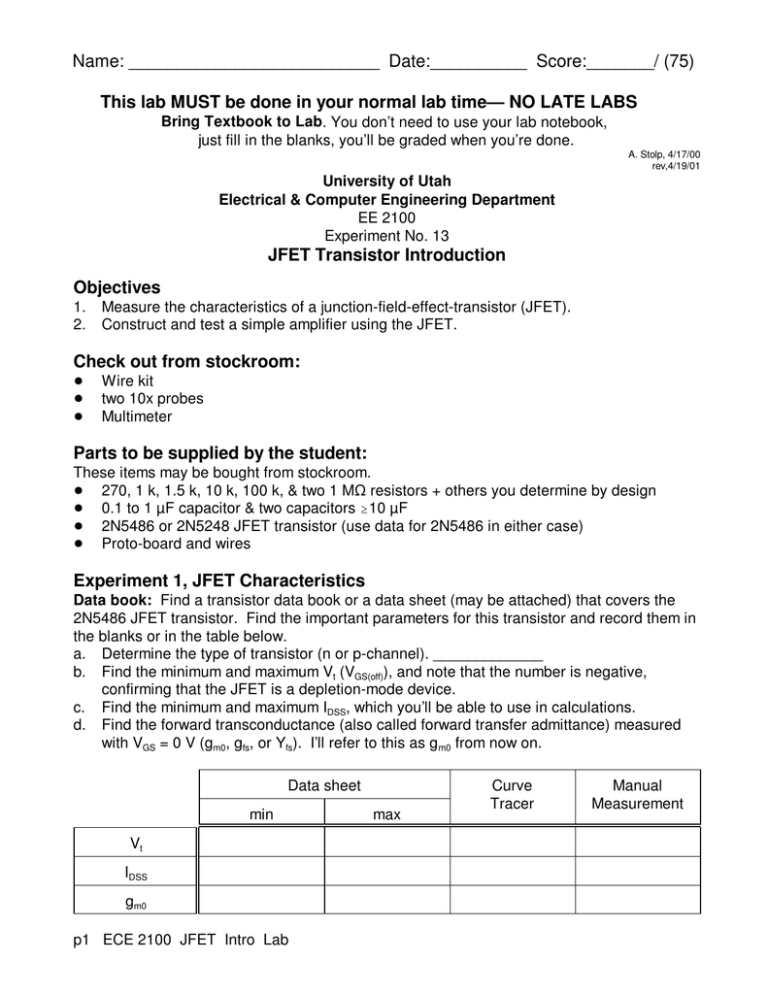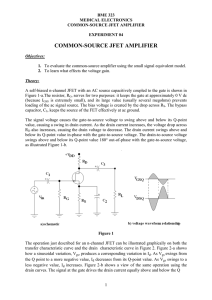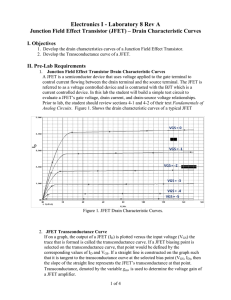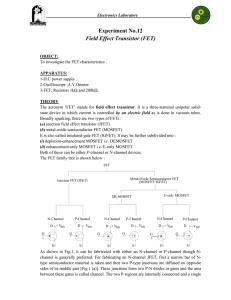JFETs - Electrical and Computer Engineering
advertisement

Name: __________________________ Date:__________ Score:_______/ (75) This lab MUST be done in your normal lab time— NO LATE LABS Bring Textbook to Lab. You don’t need to use your lab notebook, just fill in the blanks, you’ll be graded when you’re done. University of Utah Electrical & Computer Engineering Department EE 2100 Experiment No. 13 A. Stolp, 4/17/00 rev,4/19/01 JFET Transistor Introduction Objectives 1. 2. Measure the characteristics of a junction-field-effect-transistor (JFET). Construct and test a simple amplifier using the JFET. Check out from stockroom: Wire kit two 10x probes Multimeter Parts to be supplied by the student: These items may be bought from stockroom. 270, 1 k, 1.5 k, 10 k, 100 k, & two 1 M6 resistors + others you determine by design 0.1 to 1 µF capacitor & two capacitors 10 µF 2N5486 or 2N5248 JFET transistor (use data for 2N5486 in either case) Proto-board and wires Experiment 1, JFET Characteristics Data book: Find a transistor data book or a data sheet (may be attached) that covers the 2N5486 JFET transistor. Find the important parameters for this transistor and record them in the blanks or in the table below. a. Determine the type of transistor (n or p-channel). _____________ b. Find the minimum and maximum Vt (VGS(off)), and note that the number is negative, confirming that the JFET is a depletion-mode device. c. Find the minimum and maximum IDSS, which you’ll be able to use in calculations. d. Find the forward transconductance (also called forward transfer admittance) measured with VGS = 0 V (gm0, gfs, or Yfs). I’ll refer to this as g m0 from now on. Data sheet min Vt IDSS gm0 p1 ECE 2100 JFET Intro Lab max Curve Tracer Manual Measurement Curve tracer: NOTE: if the curve tracer is in use, skip this step now and come back to it later. Obtain the characteristic drain curves for this FET on the curve tracer (iD vs vDS for a series of vGS values like those shown at right. Be sure to observe how the FET operates with a small positive gate voltage (<+0.7V) as well as with the more normal negative voltage. When vGS (Vg on curve tracer) is greater than 0V the transistor is operating in the enhancement region. See if the cursor will give you the transconductance (gm) for the vGS = 0 curve (gm0). Hit the STORE button on the curve tracer. Print a copy of these curves and staple them to the lab. Label the Vgs values like I did mine, above. You’re going to do something a little strange now, But it should demonstrate just how symmetric an FET is. Pull your JFET out of the connections and put it back in backwards-drain into the S terminal, source into the D terminal and the gate where it should be, in the G terminal. Take a second set of curves over the top of the set you just stored. Are they close to the same?_____________ The only difference between the source and drain is that the FET will be designed so that the drain side has better heat dissipation characteristics. If you were not able to find gm0 using the cursor, find it now from your printed curves. Refer to my example curves, above. (on my example curves: gm0 = iD/vGS = 7.7mA/1V = 7.7mA/V = 7700 µmho). Find Vt and IDSS for this FET from your printed curves. Note: There is a small chance that your JFET’s Vt is less than -4.5V. In that case, you won’t be able to find Vt here. Add all these values to the table on the first page. Manual: Build the circuit shown. This circuit will let you find the Vt (VGS(off)) and the transfer characteristic curve (saturation iD vs vGS like Fig 5.21c, p.378 in your book). The voltmeter across the 1 k6 resistor allows you to measure the drain current and the variable voltage supply allows you to vary the gate voltage. Note: You can use two separate outputs of the HP power supply or you can make the HP 33120 output DC by holding down the Offset button for 2 seconds. Just remember that it shows double its actual output voltage. ALSO: note the polarity of the DC supply. p2 ECE 2100 JFET Intro Lab VGS ID 0V Turn the variable supply down to 0 V, and measure the drain current. Increase (make more negative) the variable supply voltage in small steps and record the data in the table. Take enough points to get a good plot. Pay particular attention to getting a good value for Vt (VGS(off)), where ID = 0. Plot an accurate transfer characteristic curve above. Determine a value for gm0 (the slope of the curve at vGS = 0,) from your data or plot (draw a tangent line and find its slope). Enter your values of IDSS, Vt, and gm0 in the table on the first page. Compare the data-sheet numbers to those you found from the curve tracer and from your measurement circuit. Experiment 2, JFET Amplifier Bias Design: Figure 2 shows a simple self-bias circuit for a depletionmode FET. VG = 0 and VGS = -VS = -RsID. Determine a suitable value for RS from the data sheet numbers. A quick-and-dirty way to find a reasonable RS is: RS |Vt| IDSS If you look at the curve at right you can see where this comes from. Calculate this once for the maximum |Vt| and IDSS values from the data sheet and once again for the minimum values. Average your two RS values to pick a standard resistor value for RS. (Space is provided on the next page.) p3 ECE 2100 JFET Intro Lab RS |Vt| I DSS For max |Vt| and IDSS : For min |Vt| and IDSS : Now that you have a value for RS, calculate a minimum and a maximum ID. Solve the equation below for ID. Do it once for the maximum |Vt| and IDSS values from the data sheet and once again for the minimum values. (I got about 2.9 & 8.1 mA, use those now if you want to make your own calculations later). 2 2 2 R S ID 2[(VGVt)RS Vt 2IDSS ]I D (VGVt)2 0 You’d like to select a value for RD so that VD is about midway between VDD and |Vt|. Try this for your two cases. Dismal results, aren’t they? OK, select RD so that in the worst case VD is |Vt| + 2 V (I got about 1.5 k6, use that now if you want to make the calculations later). VD must always be greater than |Vt|, no matter what the drain current is, or your JFET will fall out of saturation. (More space on next page.) p4 ECE 2100 JFET Intro Lab Notice that this design process is a pain because the characteristics can vary so much from part to part. Build amp: Construct the amplifier shown without the bypass capacitor, CS. Use the values of RS and RD that you selected earlier. Measure the DC VS and VD and calculate ID from your measurements. Plot this bias point on your earlier transfer characteristic curve (the one you took manually), it should fall somewhere on the curve. Gain: Adjust the signal generator to 1 kHz and apply a small input signal and observe both the input and output with the scope. Turn up the input signal until you can begin to see distortion in the output signal. The distortion you are looking for is an asymmetry in the sine wave. Turn the input signal back down to eliminate the distortion. Determine the voltage gain. How does it compare to RD/RS? Not too close, is it? The gain of an FET amplifier is more difficult to determine than that of a BJT amplifier. It is also generally much lower for a similar circuit. Add the bypass capacitor, CS, lower the input and measure the gain again. p5 ECE 2100 JFET Intro Lab Now let's try something a little strange. In the first step you saw that this FET could also operate with small positive voltages on its gate, in the enhancement region of operation. What if you change the VGS bias voltage to 0 V, that is, short RS? Think the amplifier will still work? Try it. You may have to turn down the input signal a little to eliminate distortion. What is the new voltage gain? Why did it go up? (OK, with some FETs it doesn’t go up— no, I don’t know why, it should go up.) Look back at the transfer characteristic curve you made, and see how the forward transconductance (the slope of the curve) is greater (steeper slope) at this new bias point than at the old one. With this new bias you get the maximum gm (gm0). Remove the short so RS is back in the circuit. Input resistance: Measure the output signal voltage. Remove the short across the 1 M6 resistor (the one between the signal generator and the input capacitor). Measure the new output signal voltage. Notice how little it changed. What does this tell you about the input resistance of the FET amplifier? Frequency response: Place the short back across the 1 M6 resistor or you’ll get a lousy frequency response. Turn up the input frequency to find the upper corner frequency (fCH). Conclusion Main Points of the lab 1. The large variability of Vt and the inherent non-linearity of FETs makes it difficult to design a linear amplifier or a circuit with a large output swing. FETs are usually used as small signal amplifiers or switches. 2. FETs don’t have very good gain 3. FETs have very high input impedance. Get your lab instructor to check you off and grade this handout before you tear down your final circuit. No further conclusion is necessary. p6 ECE 2100 JFET Intro Lab p7 ECE 2100 JFET Intro Lab











